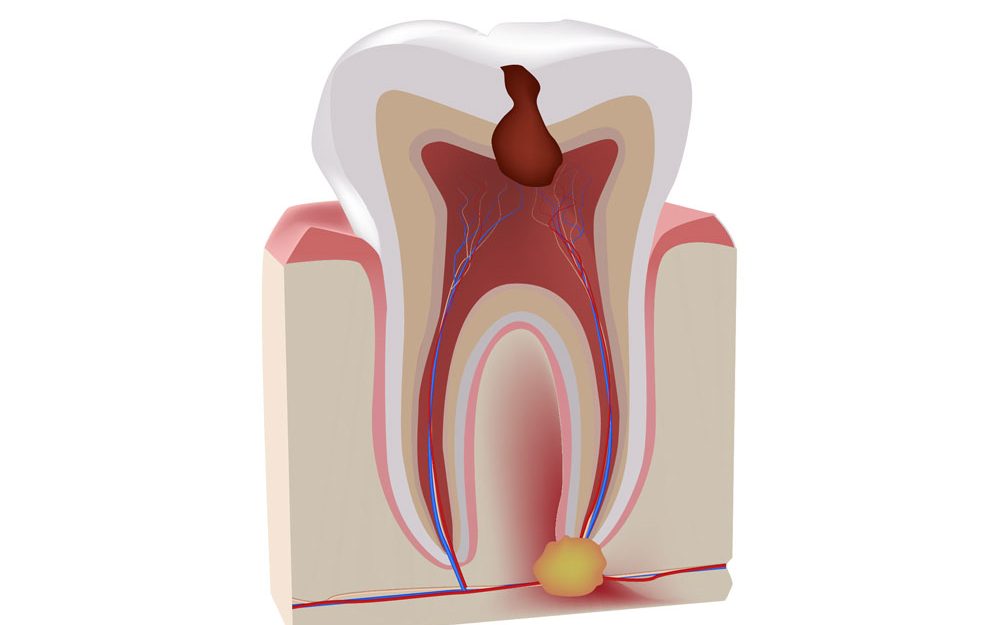To answer this question, we must first take a brief look at how a dental abscess forms.
Our teeth have three layers, the first being the protective hard layer – enamel, the second is the dentine, and the third is the core of the tooth containing connective tissue, blood vessels, and nerves collectively called the dental pulp.
A dental abscess occurs when the dental pulp, which is the core of the tooth, is invaded by bacteria. Many different bacteria reside in the oral cavity as a typical inhabitant; however, due to faulty oral hygiene practices, these bacteria and the food debris accumulate on the gums and surfaces of the teeth forming plaque.
This plaque, if not removed, later hardens to form calculus. This gives these disease-causing bacteria a place to hide. These bacteria metabolise the sugars from the food we eat to release acidic by-products, which deteriorates the tooth and leads to the formation of dental caries.
Dental caries progresses and reaches the pulp. This is how these disease-causing bacteria find a way to reach the root of the teeth. Here, the bacterial infection leads to the formation of a pus-filled cavity. This pus-filled cavity which is present with the infected tooth is known as a dental abscess.

Signs and symptoms of dental abscess
There are several signs and symptoms which can point towards a dental abscess. If you are experiencing these symptoms, it’s time to visit your dentist and get them treated.
- Severe, persistent and throbbing toothache.
- The pain of a dental abscess can even radiate to involve the entire jaw, the area in front of the ear, and the neck.
- It can even lead to headaches.
- Increased sensitivity and excruciating pain on the consumption of hot or cold foods and liquids.
- The gums around the infected tooth swell.
- Facial swelling.
- A foul taste in your mouth often accompanied by a foul smell.
If you have any of the above symptoms, it is crucial to visit the dentist with urgency. Untreated dental abscesses can progress, and the resulting complications can even be life-threatening.

Complications of untreated dental abscess
Now, this is where we answer the question – Is dental abscess dangerous? The answer is – YES, it is dangerous. Dental abscess does not go away on its own. It needs thorough dental treatment and proper diagnosis. A dental abscess can sometimes rupture spontaneously. When this happens, you may notice immediate pain relief, but this does not mean it is fixed. Ruptured dental abscess still needs proper dental treatment and requires an urgent dental check-up.
Untreated dental abscess does not drain; it progresses. The bacteria from the dental abscess now tries to find a way to go further. That means the infection will spread from your tooth’s root to the jawbone, where it can cause a condition of the bone known as osteomyelitis. Next, the infection will start involving all the facial spaces. The infection will spread, and so will the swelling.
At one point, the swelling will reach the front of the neck, causing cellulitis. This will lead to breathing difficulties as it obstructs the windpipe. This becomes a life-threatening emergency situation that requires an immediate trip to the emergency room, where this swelling will be drained.
The infection also can find a way to the bloodstream. Yes, the bacteria from the dental abscess can even enter the bloodstream. It generates a generalised inflammatory response and leads to sepsis. This infection is life-threatening and quickly spreads to the entire body involving multiple organs.
Signs and symptoms that indicate that the dental abscess has progressed
The signs and symptoms of dental abscess progression will present themselves in additions to the signs and symptoms mentioned above.
- The first sign that indicates a progression of dental abscess is fever.
- Severe headache.
- Difficulty in breathing.
- Burning and itching of the skin.
- Impaired vision.
- Confusion
- Swelling of the face and neck.
- Excessive sweating.

These symptoms suggest that the infection has spread and started to involve the entire body. At this point, higher efficacy antibiotics and hospital administration and specific life-saving procedure in combination with dental treatment will be required for effective resolution of the disease. Sepsis is a dangerous condition and spreads quickly. If treatment is delayed at this point, it can even lead to death.
A dental abscess can be easily treated by dental procedures like root canal treatment. However, once it progresses, it can be dangerous. Therefore, it is essential to note that the cure for dental abscess must not be delayed under any circumstances as the price of ignorance can be huge.
Why wait and worsen the situation when all this can be avoided easily and comfortably by visiting the dentist and getting the necessary treatment done. Prevention and conservation are always better than cure. A healthy mouth means a healthy body; schedule your appointment to ensure it!

